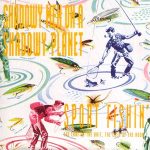
A pretty straightforward detective mystery which, despite the cover of the book, has very little to do with baseball. Even though the body count steadily increases, the story never really gets more exciting than the PI investigating clues and interviewing increasingly dull characters.

When this came out it felt like a return to form for Shellac. It opens with the fantastic “Prayer to God” which, upon first listening, any schlup (like me) would immediately run to their guitar to try to figure out. It’s a good excuse to use the F-word a whole bunch. The album loses a little steam on the second side but ends with “Watch Song.” It’s another barn burner complete with violent lyrics and the scuffling sounds of what I assume is supposed to be the fight alluded to in the lyrics.

Just when I was about to lose hope regarding my Hammer Films: Icons of Horror DVD set, I got around to watching the last film on the collection. Scream of Fear is not really a horror film and would have been much more at home on the Icons of Suspense collection. This is an excellent thriller about a wheelchair bound girl who is haunted by visions of the corpse of her missing father. It’s filmed in lovely black and white, has some good twists and contains the obligatory European-man-in-Speedo scene.

This is a zero-budget Italian take on post-nuclear sci-fi. It is utterly derivative and filled with bad acting, plot holes and cheap effects. What it does have is tons of action, a smattering of gore and George Eastman as a caveman.
Another year has passed here at the Pages of Fun so it’s time for my annual assessment of the year in media consumption. This was a pretty underwhelming year for movies. If it wasn’t for The Hobbit, which squeaked in at the last minute, there would have been no stand-out films for me this past year. To be honest, I haven’t really been keen on getting out to see movies for a while. I did love the Icons of Suspense DVD collection I bought even though I didn’t rate the individual movies that highly. I need to seek out more obscure foreign horror films this year.
For me this has been the year of the Kindle. I have been reading ebooks almost exclusively since 2000—first on a old black and white Palm Pilot, then a back-lit m505, and finally on a Nintendo DS with an M3 Flash Cart before switching to the ad-supported Kindle. The Kindle is just so much better than all my old hacked ebook solutions. I have managed to get through about two books a month, which is a relentless reading pace for my word-adverse brain. Of all the books I read, I can easily say that Baby Shark by Robert Fate was the best thing I read all year. I’m sure more books from that series will be on my 2013 list.
For the most part I have devoted most of my free time to gaming. I played a ton of great titles but my favorites of the year were Mass Effect 3, Batman: Arkham City and Tomb Raider: Underworld. Steam sales are great and I already have about half a dozen AAA titles lined up to play in the upcoming months (if I ever finish the awesome Elder Scrolls IV: Oblivion) and I want to continue playing through adventure games as I await the release of Double Fine’s Adventure later this year. Consume! Consume! Consume!

Although, as someone who has played a ton of Minecraft, I did enjoy watching this documentary about its creator(s). But the film really is lacking. When it was all done, I didn’t feel like I learned anything new about Minecraft, indy-game development or Notch himself. There’s a sequence where Minecraft is being used in a classroom, but there is no effort to show why the game is so unique in that environment. It’s just a bunch of kids and teachers telling us how much the kids like to play Minecraft in class. This lack of substance is pretty much how the entire documentary goes throughout the whole thing.

I can’t believe I went through the 80’s without ever seeing this movie or any of its sequels. Charles Bronson is great from the get go when we see him luxuriating on the beach in a Speedo, to scenes of him doing architecture stuff with big old man glasses, and then to the scenes of him blowing away dirtbags and street scum. I was never quite sure if the film is intended to be a darkly critical characterization of law and order conservatism or just a straight up revenge film where you are supposed to root for the anti-hero. That final frame of the movie is one of the most pitch perfect ways this movie could have ended and is the reason I walked away from this movie loving it.

One of the best indie rock records released after I stopped caring about indie rock. Every Shellac album is worth owning. but they tend to all sound about the same. At Action Park remains their best work. The songs are loud, precise and to the point. No twelve minute long bouts of self-indulgence here.

The final Shadowy Men album sounds much better than its predecessors thanks mostly to Albini’s roomy recording style. However, I don’t like this one quite as much as the previous two. The songs are perhaps a little less catchy? A little too serious? I’m not sure. Still, it’s Shadowy Men so there really isn’t much to complain about.

I loved the Lord of the Rings movies so I realize I have a huge bias towards liking this no matter what. So, yes, I loved this movie. I looks much better than LOTR and the acting is much improved too. The story is not as strong though. It feels padded with a little too much reliance on flashback, and, as usual, I would have liked to see less CGI creatures and more latex. Can’t wait for part two.





